Key takeaways:
- Injuries in B-Boying are common and can range from ankle sprains to wrist and back injuries, often resulting from a lack of proper warm-up and overexertion.
- Preventative measures include warming up, recognizing personal limits, and incorporating strength training to enhance performance and reduce injury risk.
- Mental recovery from injuries is crucial, with strategies such as visualization and seeking community support playing a significant role in healing.
- Sharing personal injury experiences fosters community connection and provides encouragement, reinforcing that dancers are not alone in their challenges.
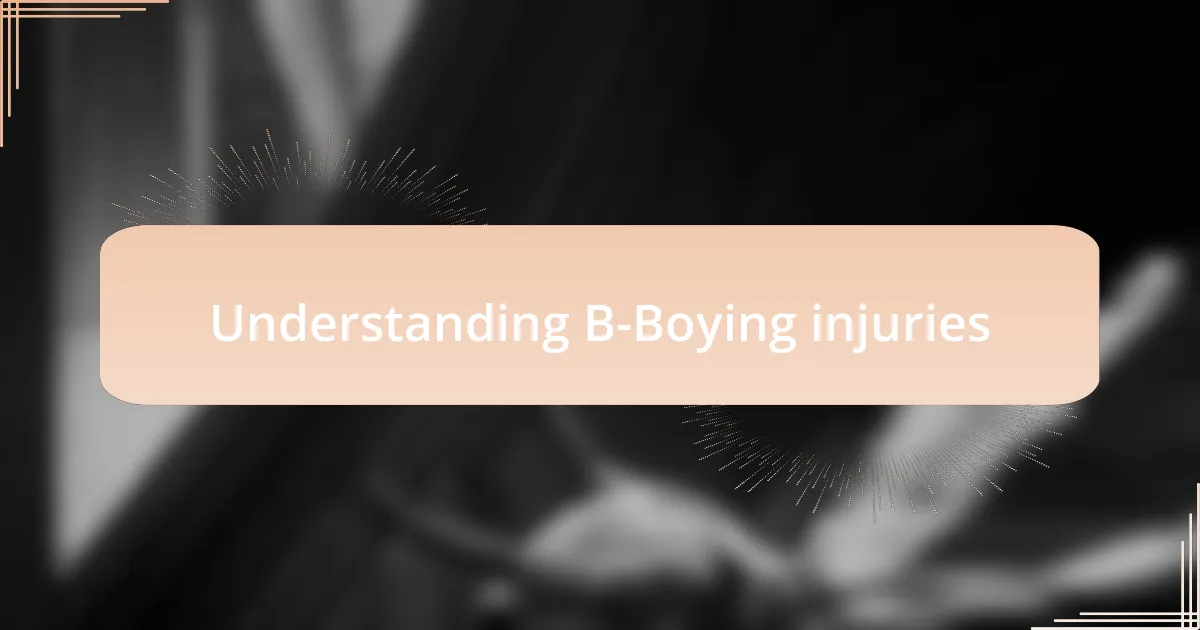
Understanding B-Boying injuries
In the world of B-Boying, injuries can range from minor sprains to significant joint issues. I remember my first serious fall during practice; the sharp pain in my ankle was a harsh reminder that even a split-second mistake can have lasting effects. Have you ever experienced that moment where everything slows down, and you realize something is wrong?
Understanding the physical demands of B-Boying is crucial. Each move—whether a power move or a freeze—puts stress on our bodies, leading to possibilities of overuse injuries. I’ve experienced the frustration of pushing through pain because I didn’t want to miss a session. It’s easy to underestimate how critical it is to listen to our bodies and recognize the signs of fatigue.
Moreover, not every injury is visible; some linger beneath the surface, affecting how we dance and interact with our community. I once ignored a nagging ache in my shoulder, thinking it was just fatigue, only to find out later that I needed rehabilitation to recover fully. How often do we push ourselves, thinking we’re invincible? Understanding injuries is about acknowledging our limits and learning how to care for ourselves, both physically and mentally.
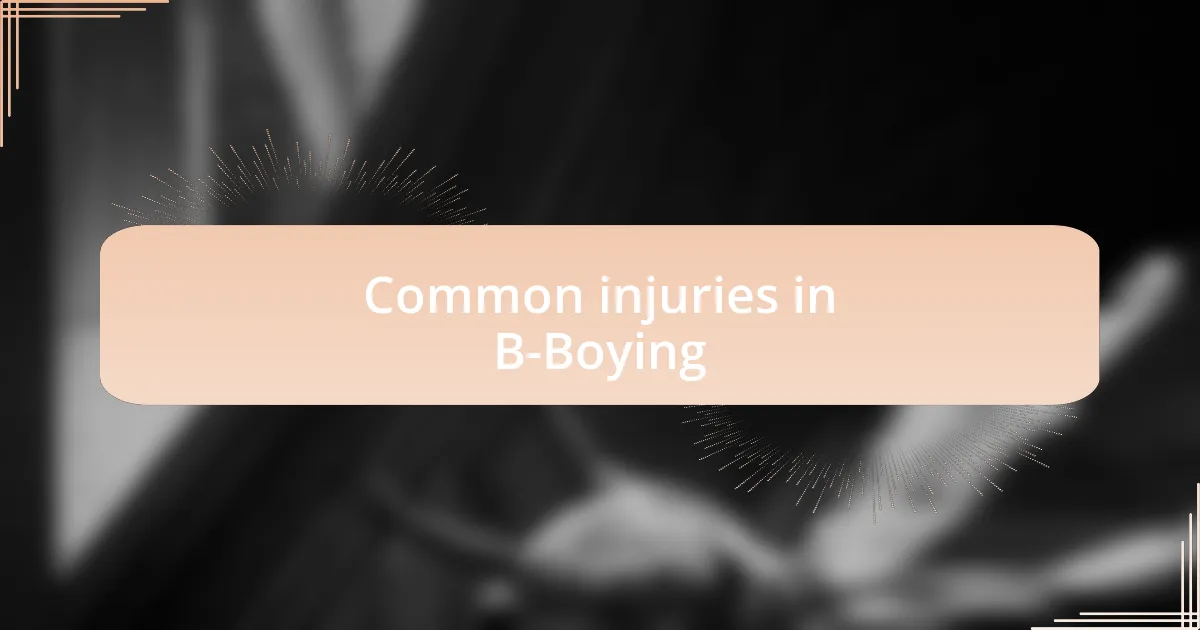
Common injuries in B-Boying
B-Boying, with its gravity-defying moves, often leads to injuries that can be surprisingly common. From my experience, ankle sprains are one of the top culprits. I remember a time when I tried to execute a new move and landed awkwardly. That sharp twist in my ankle made me realize just how vulnerable we can be, and it took weeks for me to get back on the floor, reminding me to be cautious with new tricks.
Wrist injuries are another frequent issue among dancers. I vividly recall the moment I felt a sharp pain in my wrist after executing a windmill too aggressively. It was a wake-up call—I had overlooked proper warm-up techniques. This taught me the importance of building strength in our wrists; they bear much of the impact. Have you ever felt that moment of hesitation when knowing a trick might be too much for you? Trusting our instincts is key to preventing these kinds of setbacks.
Finally, back injuries can sneak up on us, especially when we push our limits during practice. I faced this reality after a long session of freezes and spins, only to find myself struggling to stand up straight the next day. It’s a reminder that our bodies, while resilient, need care and attention. How often do we forget to check in with ourselves after a demanding routine? Prioritizing recovery is essential; we’re not just athletes but also artists, and we need our bodies to express ourselves fully.
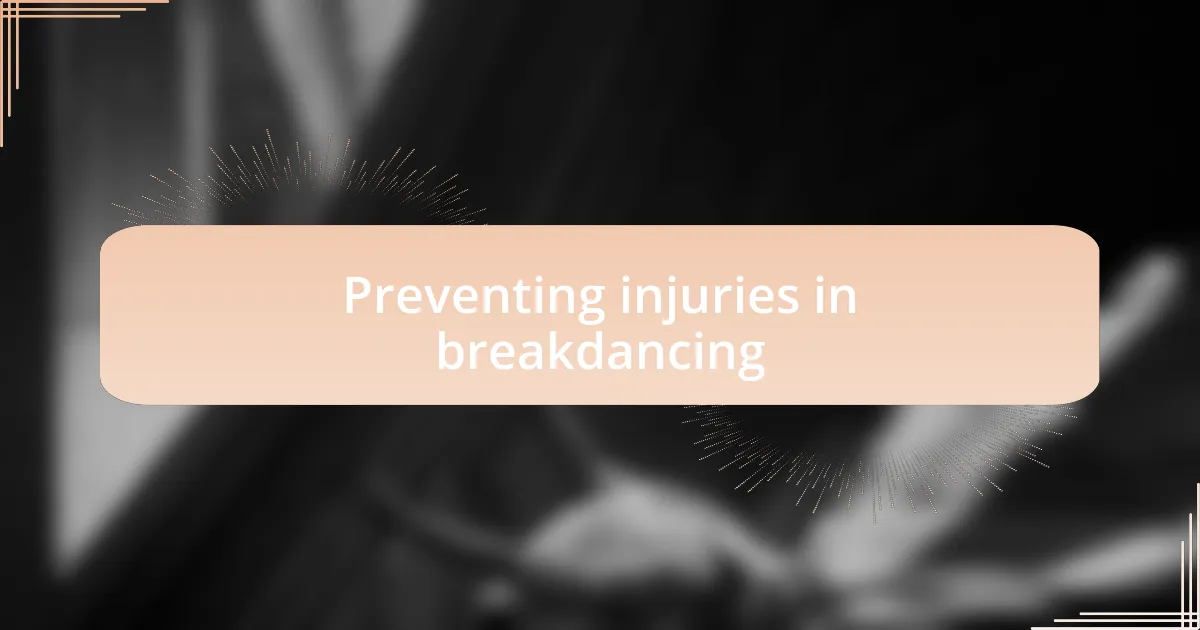
Preventing injuries in breakdancing
Taking proactive steps in breakdancing can significantly reduce the risk of injuries. I’ve learned the hard way that warming up isn’t just a mere formality. On days when I take my time to stretch and gradually increase my movements, I feel more agile and less prone to mishaps. Have you ever noticed how your body responds when you skip this crucial step? It’s like trying to start a car with a cold engine—just not running smoothly.
Moreover, knowing your limits becomes vital in this dance form. I once pushed myself to master a challenging power move, only to find myself on the floor in pain after a few attempts. It took some serious reflection to understand that greatness doesn’t come from reckless abandon but from controlled practice. How often do we chase a trick without considering our current abilities? Recognizing where I stand has helped me cultivate a safer and more sustainable practice routine.
Nurturing strength and flexibility is another key to injury prevention. I remember incorporating strength exercises into my regimen after feeling fatigued during long sessions. Not only did I feel empowered during dance, but it also built a solid foundation that helped prevent injuries. Have you considered adding strength training to your routine? It can be a game-changer, transforming not just your performance but also your endurance on the dance floor.
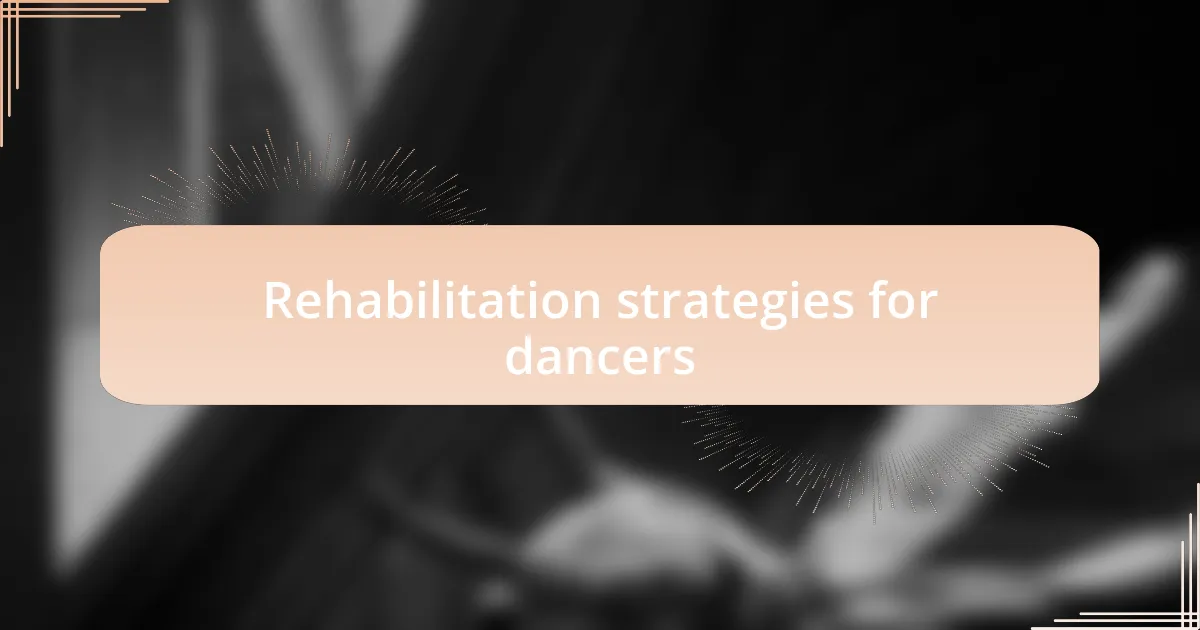
Rehabilitation strategies for dancers
Rehabilitation strategies for dancers are crucial for getting back on track after an injury. When I injured my ankle, I learned that rest alone wouldn’t cut it; combining rest with rehabilitation exercises was essential. Physical therapy became a space where I rediscovered my body’s capabilities slowly and safely—doesn’t it feel empowering to get back into the groove, even if it’s just gentle movements?
Another strategy that worked wonders for me was cross-training. I took up yoga to enhance my flexibility and mindfulness, which helped me not only heal but also avoided future injuries. It’s incredible how focusing on breath and balance can transform your recovery. Have you explored activities outside of breakdancing that can complement the healing process?
Lastly, keeping a journal of my progress proved invaluable for motivation. Writing down my daily achievements, no matter how small, helped me maintain a positive mindset during my recovery. Reflecting on my journey made me realize that every dancer’s rehab story is unique—what strategies have you tried that worked for you?
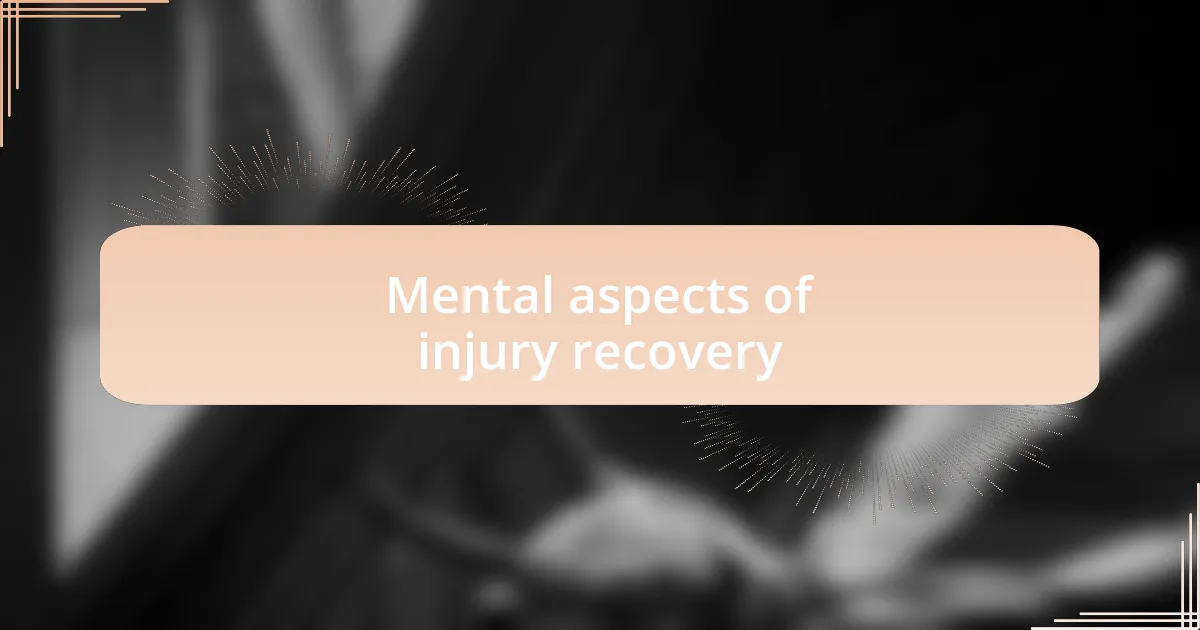
Mental aspects of injury recovery
The mental journey after an injury is often as challenging as the physical one. I remember feeling like I had lost part of my identity when I could no longer dance. It’s important to acknowledge these feelings because they are valid; our art form is intertwined with who we are. How do you cope when your self-expression is suddenly halted?
Visualizing success played a pivotal role in my recovery. During those tough days, I spent time imagining myself back in the cypher, dancing fluidly and confidently. This mental rehearsal not only kept my spirits high but also helped reinforce the belief that I would return stronger. Have you ever tried visualization techniques to keep the fire alive during difficult times?
It’s also worth noting the power of community support. Sharing my experiences with fellow B-Boys and B-Girls helped me feel less isolated. Their stories of resilience inspired me to keep pushing forward—it’s amazing how just knowing you’re not alone can shift your mindset. Who has your back when you’re facing tough times, and how do they lift you up?
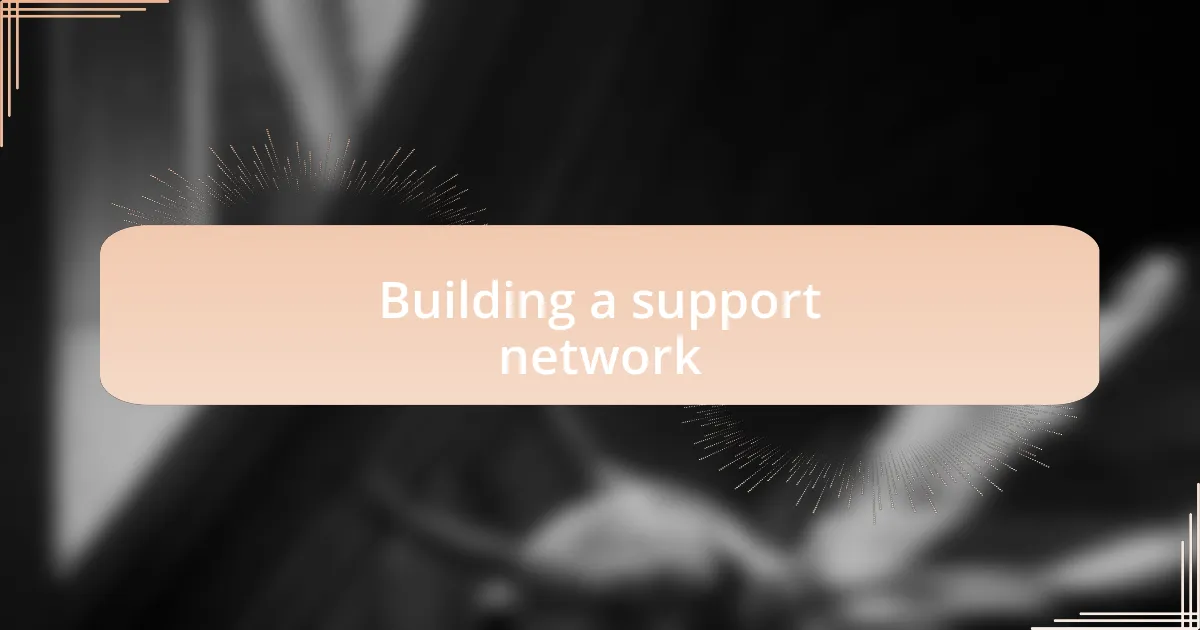
Building a support network
Building a support network in the B-Boying community can make a world of difference during recovery. I vividly recall the moment I reached out to my crew after sustaining an injury; their encouraging words felt like a lifeline. Have you ever realized just how powerful the connections you build can be when you’re facing hardship? Leaning on those close to you creates a safety net that helps cushion the emotional blows.
Surrounding yourself with fellow dancers who understand the unique challenges of breakdancing is essential. I remember joining a small support group where we shared our injury stories and recovery tips. It made me feel less like an outsider and more connected to a larger family. There’s something about knowing that others have walked your path, right? Their shared experiences remind you that resilience is a shared journey, not a solo endeavor.
Beyond just emotional support, practical help from your network can be invaluable. During my recovery, my friends would call me to brainstorm new routines that accommodated my limitations, allowing me to stay engaged with the art. The feeling of being supported while still being part of the scene was incredibly uplifting. How can your community contribute to your healing when it matters most? Engaging them can spark creativity and keep your passion ignited, even in tough times.
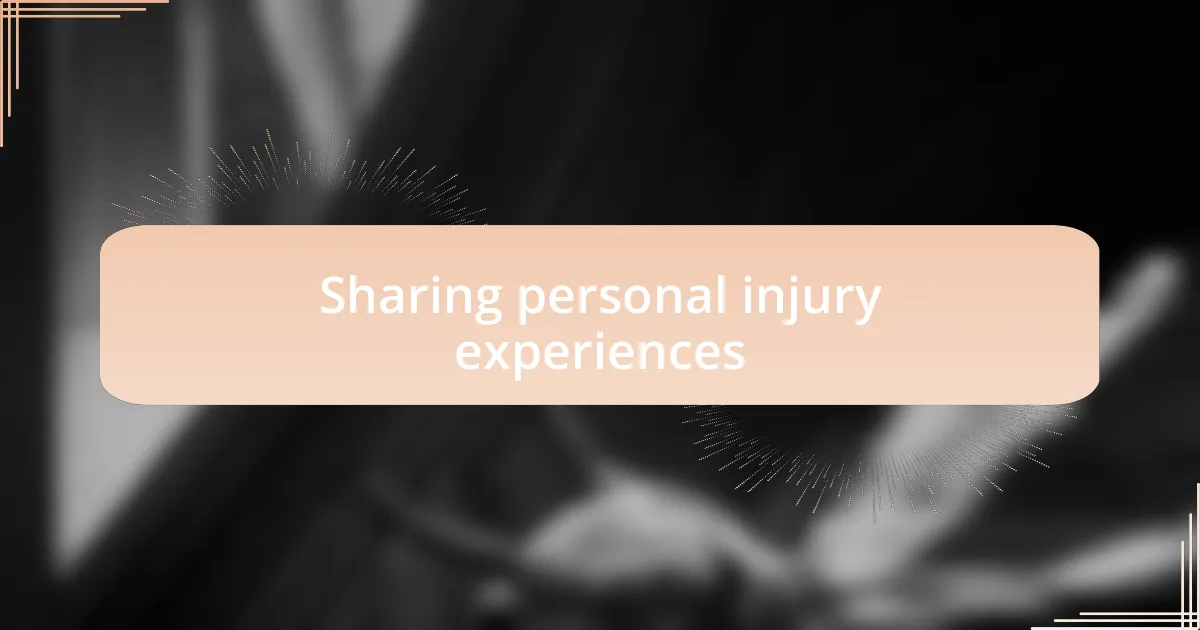
Sharing personal injury experiences
Sharing personal injury experiences can be a profound way to connect with others in the B-Boying community. I distinctly remember when I injured my ankle during a battle. It was disheartening, and sharing the experience felt like lifting a weight off my shoulders. When I opened up about my struggles, others began to share their stories as well. It was comforting to realize that I wasn’t alone in this journey.
I often reflect on a conversation I had with a fellow B-Boy who had dealt with a similar knee injury. Hearing how he navigated his recovery provided me with practical insights and a sense of hope. It made me wonder, how many others would benefit from just basic storytelling about our injuries? Each story shared can foster a sense of camaraderie and encouragement that we all need during tough times.
In another instance, after sharing details of my rehabilitation process on a forum, I received an outpouring of advice and support. It was heartwarming; the community rallied around me, offering tips on recovery and even sharing their own setbacks. Isn’t it amazing how our vulnerabilities can unite us? Each shared experience not only aids in healing but also strengthens the bond among dancers, proving that challenges can indeed bring us closer together.